*Updated on 4 November 2022. We have updated some charts and figures to correct errors in original calculations. This doesn’t affect any findings.*
The new Schools White Paper sets out the government’s plans for all schools to either be part of, or have plans to join, a strong multi-academy trust (MAT) by 2030.
Exactly how a strong trust will be defined is a topic for another day. But one thing that we do know is that the government isn’t keen on small or single-academy trusts. They’ve said that in future they’ll expect most trusts to run at least 10 schools, or at least be working towards it.
So this seems like an opportune moment to take a look at how big MATs are at the moment, and how that’s changed over time.
We’ll be using public data covering the period 2018-22.
Some background
As of early 2022, there were 2,539 trusts operating in England, made up of nearly 10,000 schools. [1] The chart below shows how these were distributed between the regions.
To keep things relatively simple, we’ve put schools into three groups: academies, which includes academies, free schools, university technical colleges and studio schools; LA maintained or foundation schools; and voluntary aided or voluntary controlled schools.

In all regions, the proportion of academies has increased since 2018. The South West currently has the highest proportion of academies, at 58%, and the North West the lowest at just 26%.
Compared to other regions, the North West also has an unusually high proportion of voluntary aided or voluntary controlled schools, at 35%. The vast majority of these schools (98%) are faith schools. Any serious expansion of academies in the North West will have to involve working with the church.
Secondary schools are more likely to be academies than primary schools, as shown below.

This year, just 39% of primary schools are academies, compared to 79% of secondary schools.
Schools that have not yet academised will certainly be affected by the proposals in the white paper. But what of those that have already academised? Are most already part of a trust of the approved size, that is, at least 10 schools?
The size of trusts
In short, no.
This year, more than half (55%) of academies are either single-academy trusts (SATs) or part of a multi-academy trust with fewer than 10 schools. This is a considerable decrease from 2018, when nearly three-quarters (74%) were either a SAT or part of a smaller trust.
Overall, just 20% of schools are currently part of a MAT of 10 or more schools, so the vast majority – just over 17,500 schools – are in line to be affected by the white paper proposals.

The number of schools in large trusts of over twenty schools has increased since 2018, but there’s been a particularly steep increase in the number of academies in trusts with between 10 and 19 schools, from 1,056 (14% of the total) in 2018 to 2,561 (25%) in 2022.
The average size of MATs has increased from five schools in 2018 to seven in 2022, and the largest trust in 2022 had 75 schools, while in 2018 the largest had just 58.

Regional differences
There are some considerable regional differences in trust sizes. We should note that looking at regional differences is complicated by the fact that some trusts cover a relatively small geographical area, while others are national. More on this later.

All regions have seen a fall in the number of single-academy trusts (SATs) but it has been sharper in some areas than others. At present, London and the South West have a higher proportion of SATs (8% and 7%) compared to 4% in both Yorkshire and the North East.
The North East has by far the highest proportion of schools in large MATs of twenty or more schools, at 15%.
National trusts
As noted above, some trusts focus on a relatively small geographical area. But others could be described as ‘national’ trusts – that is, MATs that include schools from around the country rather than focusing on one local area.
At present, national trusts are not the norm even among larger MATs. As shown below, the majority currently operate in just one or two regions.

The proportion of larger MATs operating in three or more regions has fallen since 2018, but the number has actually risen slightly, from 14 in 2018 to 19 in 2022. The lower proportion is due to the increase in the number of larger MATs over the same period.
Primary vs secondary
While primary schools are less likely to be part of a trust than secondary schools, those that are in a trust are more likely to be part of a larger MAT.
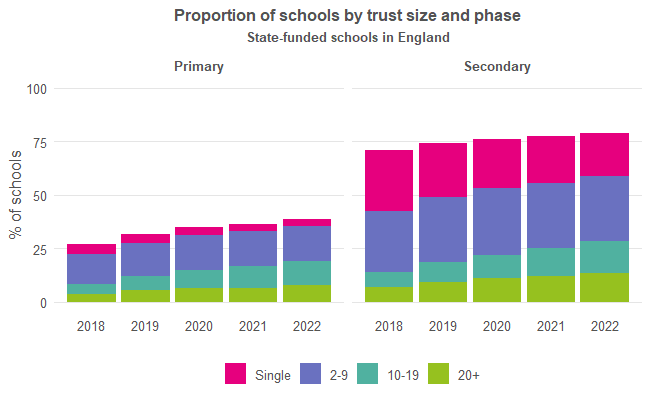
At present, only 3% of primary schools are part of a SAT compared to 20% of secondary schools. And, while overall a higher proportion of secondary schools are part of a larger trust of 10 or more schools than primaries – 29% compared to 19% of primaries – secondary academies are less likely to be part of a larger trust than primary academies.
Half of primary academies are part of a trust of 10 or more schools, compared to 36% of secondary academies.
What next?
We’ve seen that the number of schools that are part of a trust is on the increase, as is the proportion that are part of a trust with at least 10 schools.
But what’s likely to happen to those schools that aren’t currently part of such a trust?
Let’s take a look at what’s happened in the past. Between 2021 and 2022, 607 schools became part of a MAT of 10 or more schools, having previously been either part or a smaller trust, or not in a trust.
The most common route into a larger MAT was being part of a smaller MAT that expanded – 39% of new joiners fell into this category. Just under a third (29%) had not been part of any trust before, and the remaining 32% moved from a smaller trust.
If this pattern continues over the next few years, we might expect to see an increase in the number of mid-size MATs as smaller MATs expand, but also an increase in the number of schools in large MATs as more schools academise or move from smaller trusts.
What next for trusts?
Of course, the new policy may prompt changes, not only in schools’ decision making process but in that of trusts.
Some of the larger trusts may look to move away from mainly recruiting underperforming, sponsored academies and towards recruiting those with a strong performance record, or absorbing existing smaller trusts.
It’s also worth noting that the White Paper included the promise that, in the interests of choice, there will be limits on the proportion of schools in a local area that can belong to one trust.
There may be an increased role for the Regional Directors (formerly known as Regional Schools Commissioners) in coordinating all of these changes, ensuring that no one trust becomes dominant in an area, and supporting schools and trusts.
Thanks to Steve Rollett for comments on a draft of this article.
- We have included academies, free schools, studio schools and university technical colleges, including special schools.

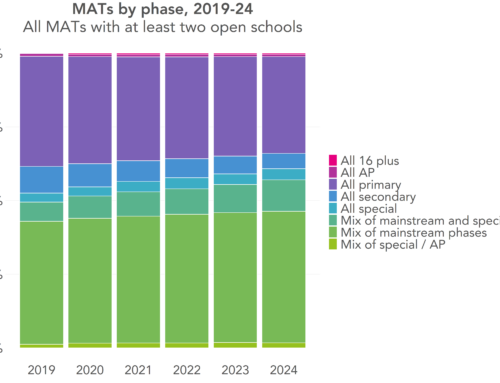
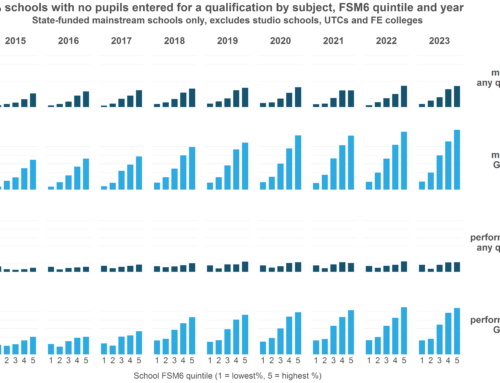
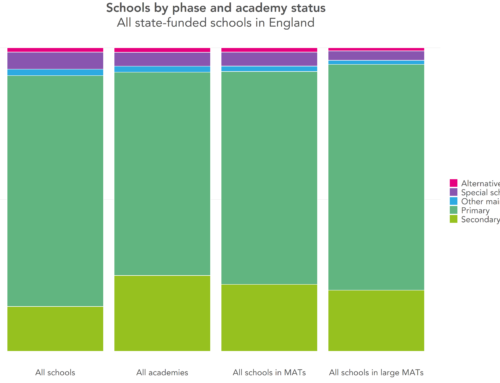
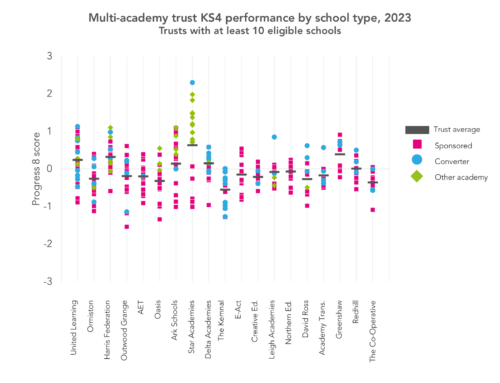
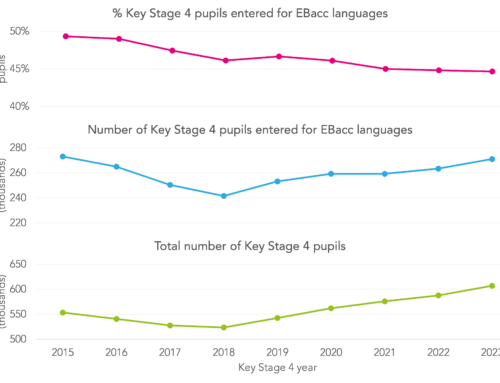
White paper link is broken.
Thanks Paul, it seemed to be working for me but I’ve updated it so it goes to the report landing page rather than direct to a PDF, hopefully that should work for everyone.
Interesting data but depressing that local democracy will be the loser. This is reinventing LEA-type infrastructure without any democratic or managerial safeguards. Thank goodness Scotland has rejected this nonsense.
How many MATs does the DFE have in mind in the “Fully trust led system” referred to in the White Paper proposals, ball park?
Good question, so far as I know the DfE haven’t given any indication. To give a v rough idea, ATM there are about 1,200 MATs, but only about 250 have more than ten schools. On average these larger trusts have 18 schools. There are 17,500 schools who aren’t yet a part of a trust of more than ten schools – to accommodate them all we’d need around 17,500 / 18 = 972 large MATs. So 972 + 250 = 1,222 MATs in total. In practice it’ll probably be less as the average size will probably increase too.
above you advise: ATM there are about 1,200 MATs however in the article you state:
As of early 2022, there were 2,539 trusts operating in England – which number is correct please?
thanks
Hi Victoria, the trusts figure includes single academy trusts, while the MATs figure only includes trusts with two or more schools. So confusingly they are both right! I should probably have made that clearer in the article.
This is such an interesting article! I’d love to see some of the detail in the regional breakdown. Are the percentages within the table available somewhere?
Hi Kirstin – thanks, glad you enjoyed it! Everything is based on extracts from public GIAS data. Here’s a table with all the figures I used to create the regional chart – hope that’s what you were after. Obviously the numbers may be slightly different now as it’s getting on for a year since this analysis was done – we’re thinking of doing a follow up with the latest figures when we get a mo.
Hi Natasha, great info here!
Are there any stats available on the size of MATs by pupil numbers rather than by constituent schools?